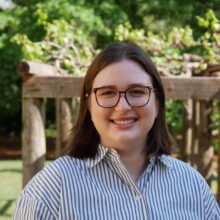
When Courtland Hardy saw a thick red packet in the mail, he knew he had been accepted to North Carolina State University.
Growing up in a mobile home in rural North Carolina, he recalled being told that he would never be able to make anything of himself. Determined to prove those people wrong, he threw himself into school, burying his nose in books and consistently getting perfect attendance and honor roll grades.
All his hard work paid off. Upon graduating from Surry Early College, he already had an associate degree and a good enough GPA to get scholarships. He says he wouldn’t have been able to afford it otherwise.
Growing up with a single mom, he started helping take care of his family as soon as he could. When she was diagnosed with stage 3 cervical cancer a month after his acceptance and could no longer work, he essentially became the breadwinner.
That responsibility continued when he moved three hours away for college. So on top of taking a full course load, he got a job.
His scholarships covered his housing during the semester. When it came to winter and summer breaks, however, students are expected to clear out of the on-campus dorms. But he still had to work at his job for another week.
He could pay the $345 fee for the entire month just to use it for a week, or he could drive three hours every day in his 1990 Jeep Cherokee that he says gets about 8 miles to the gallon.
Neither of those being viable options, he spent the week sleeping in his car.
During the 2019-20 school year, one in 10 N.C. State students went through something like what Courtland experienced.
According to a survey of undergraduate and graduate students at N.C. State, 9.8% of students experienced homelessness sometime in the 2019-20 school year, meaning they didn’t have a place to sleep for at least one night. That number increased to 15% during the pandemic.
Two researchers and advocates have been leading a years-long effort to expand services to students facing food and housing insecurity at N.C. State and for college students more broadly. Out of this study has come a program that could be one of the first of its kind in the country.
They are set to launch a “Host Home” program, where students experiencing housing insecurity will be matched with hosts in Wake County on a temporary basis. This program has been replicated in communities across the country, and this could be one of the first programs targeted at college students.
Starting a host home program
“All roads lead to Sarah,” Mary Haskett says.
Sarah Wright joined N.C. State’s staff 12 years ago. Having experienced housing and food insecurity herself, she feels a personal connection to her work as the assistant director of student support services in the university’s TRIO offices.
TRIO programs, funded under Title IV of the Higher Education Act of 1965, are meant to “help students overcome class, social, and cultural barriers to higher education,” according to its website. This means, among other things, connecting them with mentor opportunities as well as other resources to help them succeed.
Mary Haskett, professor of psychology at N.C. State, researches family homelessness. When she found out that one of her students was unhoused, she went to Wright.
As the two sat down to talk about the student’s options, they realized more needed to be done for these students.
In many ways, college students experiencing homelessness face unique barriers. When students are in public K-12 schools, they attend institutions governed by the McKinney-Vento Act. This law provides funding to each district, while requiring them to have a liaison who is tasked with serving these students.
That’s a federal law, though, and it doesn’t extend past a student’s senior year in high school.
“Those students in K-12 who are food insecure and housing insecure don’t suddenly become resourced once they take a step on campus,” Wright said.
For students who may rely on free-and-reduced lunch, or whose families are couch surfing, she added, what happens to those students?
“I think people tend to, when they think of college students, have a really traditional student in mind. It’s the young students straight out of high school, no children. And that’s no longer the traditional college student. And the needs of the college student population have really changed.”
Mary Haskett, psychology professor at N.C. State University
The two formed an all-volunteer housing and food insecurity steering committee, made up of what they call “individual concerned citizens.” Its members vary from former students to food bank representatives.
The committee, now going into its fifth year, focuses on providing direct services to students — things like improving the on-campus food pantry, or setting up an emergency fund.
The idea for setting up a host home program came when the university gave Wright and Haskett a small grant to study homelessness on campus. They spent a year researching and consulting with community members and students who had experienced homelessness trying to find viable, campus-based solutions.
Among those they surveyed, the idea of starting a host home program was the most popular solution.
They got the idea from Point Source Youth, a national nonprofit working on solutions to youth homelessness. The organization advocates for four different community-based programs, one of which is host homes.
Brittany Garner, director of programs for Point Source Youth, said her mom was a host home before she even understood what the concept was.
“We called our house the land of misfit toys because it was where our friends would crash for a few months if they needed to,” she said. “They would stay with us to be able to stay in school, or keep their job.”
She said her organization worked with Haskett and Wright to help them fundraise and provide advice along the way. Point Source Youth has a 119-page guidebook that lays out how to start a host home program, including guidance on screening potential hosts and budgeting.
Point Source Youth works with 70 communities across the country, over 40 of which have host homes. But Garner pointed out that this concept isn’t exactly new, and many more communities likely have informal host homes.
Haskett said the committee has already raised $100,000 and is in the process of hiring a program coordinator. They are hoping to launch the host home program in fall 2022.
“This will be a temporary, short-term, but safe and affirming spot for students to land so that they can focus on their education,” Haskett said. “Not having that stable place to live takes an incredible toll on students’ behavioral health, mental health, their wellness, and their education.”
‘Not the only person with that story’
When COVID-19 hit and the university shut down, Hardy went back to his hometown and tried to find a new job. After sending in applications for a month and hearing nothing, and with his mom’s medical bills piling up, he told his family he would have to go back to his old job in Raleigh.
To keep his mom from worrying, he lied and told her he would stay with a friend.
In reality, he went back to living in his car.
“I’m not the only person with that story,” he said. “… It happens more than I think society cares to admit.”
Hardy says having a host home as a housing option during his last four years of college would have been “truly life changing.”
“For people to come together and be willing to help us without judging us is monumental,” he said.
For Haskett and Wright, the idea for starting a host home program came out of the desire to do more than study problems — they wanted to “get busy.” But at the same time, they acknowledge that these programs aren’t a solution to youth homelessness on their own.
“This is not an upstream effort. We are, in many respects, waiting for students to be struggling,” Haskett said. “But at the same time that we’re addressing the current immediate need, we are trying to look upstream to these systems-level approaches.
“We’ve made incredible progress in four years,” she continued, “but what more could happen if it wasn’t a loose association of volunteers?”
Behind the Story
This story was produced with support from the Education Writers Association Reporting Fellowship program.
Recommended reading



